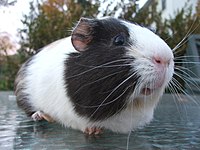
Photo from wikipedia
Guinea grass (Panicum maximum Jacq., renamed Megathyrsus maximus Jacq.) is a native forage plant in Africa of great economic value, but it was introduced in almost all tropical countries as… Click to show full abstract
Guinea grass (Panicum maximum Jacq., renamed Megathyrsus maximus Jacq.) is a native forage plant in Africa of great economic value, but it was introduced in almost all tropical countries as a source of animal forage. Over the last decade, it was introduced in North arid regions of Africa (Morocco, Algeria, Tunisia, Libya, and Egypt) through authorized and unauthorized ways. It has two reproduction modes through sexual and apomictic ways. Besides its ability to provide high nutritive forage, guinea grass could affect the oases agroecosystems diversity due to its genetic aspects (apomixis and autotetraploidy) and eco-physiological traits (allelopathy effect and resistance to abiotic stress). That is why a review of genetic and eco-physiologic aspects of guinea grass is essential to investigate its potential introduction and management in new regions, particularly in arid and semiarid zones. In this paper, we review the most important traits of this plant that should be considered (polyploidy, apomixis, allelopathic effect, drought and salinity resistance, and invasion) for the potential success of guinea grass in integrated systems of forage/livestock.
Journal Title: Agronomy
Year Published: 2021
Link to full text (if available)
Share on Social Media: Sign Up to like & get
recommendations!